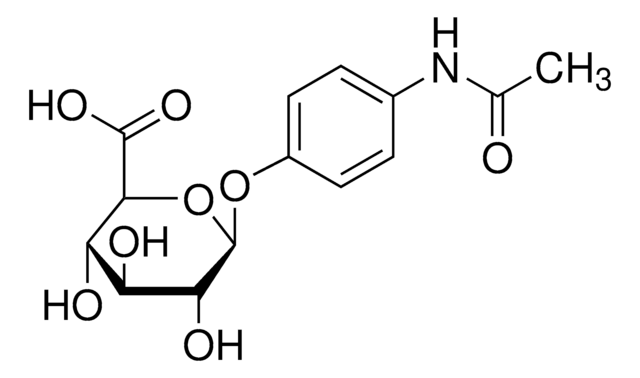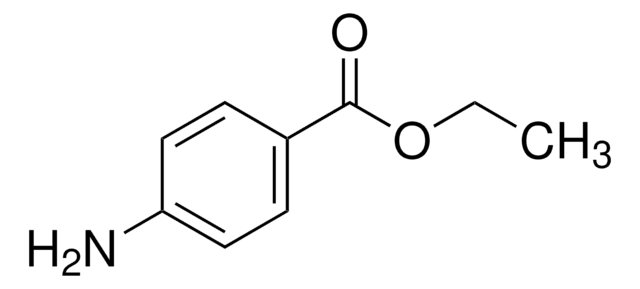A7300
N-Acetylbenzoquinoneimine
Sinónimos:
N-(4-oxo-1-cyclohexa-2,5-dienylidene)acetamide, N-Acetyl-p-benzo-quinone imine, NAPQI
Iniciar sesiónpara Ver la Fijación de precios por contrato y de la organización
About This Item
Fórmula empírica (notación de Hill):
C8H7NO2
Número de CAS:
Peso molecular:
149.15
Número MDL:
Código UNSPSC:
12352100
ID de la sustancia en PubChem:
NACRES:
NA.22
Productos recomendados
Formulario
solid
Nivel de calidad
temp. de almacenamiento
−70°C
cadena SMILES
CC(=O)\N=C1\C=CC(=O)C=C1
InChI
1S/C8H7NO2/c1-6(10)9-7-2-4-8(11)5-3-7/h2-5H,1H3
Clave InChI
URNSECGXFRDEDC-UHFFFAOYSA-N
¿Está buscando productos similares? Visita Guía de comparación de productos
Categorías relacionadas
Aplicación
Reactant involved in:
- Redox reactions
- Hydrohalogenation
- pH dependent reactions: in acidic media it is hydrolyzed, hydroxylated in alkaline media, and dimerized at intermediate pHs
- Mediation of acetaminophen hepatotoxicity
- Studies to identify the utility of acetaminophen for treating autoimmune disorders
Otras notas
Acetaminophen metabolite that reacts with serum proteins.
Precaución
air, moisture and light sensitive
Código de clase de almacenamiento
11 - Combustible Solids
Clase de riesgo para el agua (WGK)
WGK 3
Punto de inflamabilidad (°F)
Not applicable
Punto de inflamabilidad (°C)
Not applicable
Equipo de protección personal
Eyeshields, Gloves, type N95 (US)
Elija entre una de las versiones más recientes:
¿Ya tiene este producto?
Encuentre la documentación para los productos que ha comprado recientemente en la Biblioteca de documentos.
Los clientes también vieron
Angela S Burke et al.
Chemical research in toxicology, 23(7), 1286-1292 (2010-06-29)
Acetaminophen (APAP) toxicity in primary mouse hepatocytes occurs in two phases. The initial phase (0-2 h) occurs with metabolism to N-acetyl-p-benzoquinoneimine which depletes glutathione, and covalently binds to proteins, but little toxicity is observed. Subsequent washing of hepatocytes to remove
Laura P James et al.
Drug metabolism and disposition: the biological fate of chemicals, 37(8), 1779-1784 (2009-05-15)
Acetaminophen (APAP)-induced liver toxicity occurs with formation of APAP-protein adducts. These adducts are formed by hepatic metabolism of APAP to N-acetyl-p-benzoquinone imine, which covalently binds to hepatic proteins as 3-(cystein-S-yl)-APAP adducts. Adducts are released into blood during hepatocyte lysis. We
Amaresh Kumar Sahoo et al.
Nanoscale, 3(10), 4226-4233 (2011-09-08)
Herein, we report the generation of a composite comprised of p-hydroxyacetanilide dimer and Ag nanoparticles (NPs) by reaction of AgNO(3) and p-hydroxyacetanilide. The formation of the composite was established by UV-vis, FTIR and NMR spectroscopy, transmission electron microscopy and X-ray
Hui Ting Chng et al.
Journal of biomolecular screening, 17(7), 974-986 (2012-05-31)
The zebrafish model has been increasingly explored as an alternative model for toxicity screening of pharmaceutical drugs. However, little is understood about the bioactivation of drug to reactive metabolite and phase I and II metabolism of chemical in zebrafish as
Cross-linking of protein molecules by the reactive metabolite of acetaminophen, N-acetyl-p-benzoquinone imine, and related quinoid compounds.
A J Streeter et al.
Advances in experimental medicine and biology, 197, 727-737 (1986-01-01)
Nuestro equipo de científicos tiene experiencia en todas las áreas de investigación: Ciencias de la vida, Ciencia de los materiales, Síntesis química, Cromatografía, Analítica y muchas otras.
Póngase en contacto con el Servicio técnico







